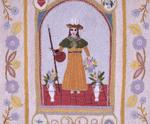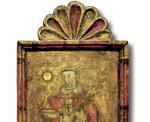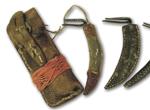After a one-year hiatus, Traditional Spanish Market returns to the Santa Fe Plaza.
Unlike other annual summer markets and festivals, such as the International Folk Art Market and Currents New Media, the Spanish Colonial Arts Society chose not to hold a virtual Spanish Market in lieu of an in-person event in 2020. Instead, the organization spent the past year revamping its website to feature market artists more prominently and increase its web presence, and it reimagined the exhibit and research spaces within the museum, the Museum of Spanish Colonial Arts.
The first Spanish Market was held in 1926 during the annual Santa Fe Fiestas. It took place in the courtyard of the New Mexico Museum of Art on West Palace Avenue under the auspices of what was then called The Society for the Revival of Spanish Colonial Arts.
In the decades since then, Spanish Market has grown into a staple of the summer season and is the largest and oldest juried Hispanic art show in the nation. Spanish Market has featured as many as 160 adult artists and 40 youth artists. This year, the number is down to 82 adults and 23 youth for 2021, and the market occupies a smaller footprint than it did in 2019, but “it works out logistically,” says Yvonne Gillespie, the society’s finance and logistics director.
“Now we can just surround the Plaza proper, but we do have a small stream of artists that are right in front of La Fonda Hotel as well leading towards the cathedral. That’s going to be the whole of our market.
“We’re going to keep the grassy area on the Plaza as available as possible for attendees,” Gillespie says. “We are encouraging people to bring their own chairs. That way, they can sit as distanced as they want to. I thought this might be the best way to handle post-COVID events.”
Spanish Market is a showcase for the traditional arts of New Mexico, which include works in textiles, painting, furniture, woodcarving, pottery, and more. The artists are juried into one or more of 18 categories.
“The way it works is, once an artist is over 18 years old, they have to jury into market with three recently completed pieces for each category” they enter, says Spanish Colonial Arts Society Deputy Director David Rasch. “Late January/early February is our jurying event when new artist can jury in and existing market artists can jury into additional categories at that time. One artist from Denver, for instance, is juried into 10 categories.”
Once the artists jury into the specific categories, their standing is good for five years.
There are, however, instances when an artist is exempt from jurying. These include recipients of the society’s Spanish Market Masters Award for Lifetime Achievements and artists that have shown at market for at least 25 years.
The work of the artists, who usually compete for cash awards and top prizes in each category, must conform to a set of guidelines for quality control. A volunteer Standards Committee composed of art dealers, curators, art collectors, and art historians with some expertise in specific art forms featured at the market, judge the works.
“Some of them have their distinct specialties,” Rasch says. “One member of the committee wrote the book on tinwork. Another member is very good with iconography and can talk about bultos and retablos and whether or not the saints are properly represented iconographically.”
The guidelines vary by category, but are designed to ensure that artworks retain a traditional framework. Hide paintings, for instance, may include Christian devotional images and narrative scenes within a landscape, but not subject matter that would be considered irreverent. Commercial paints are acceptable mediums, but handmade pigments made from plants, stones, and minerals are preferred.
The Spanish Colonial Arts Society is not holding its annual awards competition or its Friday night preview this year in recognition of the toll that the pandemic took on its market artists.
Here, Pasatiempo explores a sampling of Spanish Market categories as a road map for art forms attendees are likely to see and the artists they’ll meet. Although the market was formed to promote the local Hispanic traditional arts, a common thread between these living traditions is the theme of evolution and innovation. ◀
2021 Traditional Spanish Market
8 a.m. to 5 p.m., Saturday and Sunday, July 24 and 25, on the Santa Fe Plaza
Free public event
RELATED EVENTS
The annual Contemporary Hispanic Market (505-331-5162, contemporaryhispanicmarketinc.com) takes place from 8 a.m. to 5 p.m. on Saturday and Sunday, July 24 and 25. Ninety booths line Lincoln Avenue in Downtown Santa Fe, adjacent to the Santa Fe Plaza. The market showcases works by regional Hispanic artists in a variety of disciplines, including sculpture, jewelry, painting, weaving, and ceramics.
“Spanish Market is more in the traditional form, even though they’ve opened up a category that swings more into the contemporary side,” says Contemporary Hispanic Market President Ramona Vigil-Eastwood. “Our market is all contemporary art. So, of course, we have the many mediums that the traditional market doesn’t have, like printmaking, photography, and glass work. That’s what makes our show different.”
The event, now in its 35th year, is free to the public.
Blue Rain Gallery (544 S. Guadalupe St., 505-954-9902, bluerain gallery.com) opens its annual Spanish Market Show with a 5 p.m.
reception on Friday, July 23. The exhibition features new works by artists Lorrie Garcia, Gustavo Victor Goler, and Nicolas Otero, as well as devotional works of art from private collections, including the Webster Collection and Moure Collection. Garcia, Goler, and Otero all work in the santero tradition, creating works that explore traditional iconography of Catholic saints. The exhibit is on view through Sunday, July 25.
Alberto Zalma Art Shop (407 S. Guadalupe St., 505-670-5179, albertozalmaart.com) hosts a Spanish Market mixer celebrating being Mestizo at 5 p.m. on Friday, July 23. Carlo Ray Martinez, Alberto Zalma, and other local artists of mixed Spanish and Indigenous heritage tell their stories of being Mestizo in New Mexico and how that heritage is expressed in their art. Works will be available for sale and the event includes live music and refreshments.
Acosta-Strong Fine Art (200 Canyon Road, 505-982-2795, acostastrong.com) presents Of Earth and Sky — Paintings for a New Day, a solo exhibition by New Mexico artist Edward Gonzales. The show is presented in conjunction with Spanish Market and Contemporary Hispanic Market. Gonzales renders his expressive paintings of Hispanic life in New Mexico with vibrant color and creates compositions that evoke memories of times past. Gonzales founded Contemporary Hispanic Market in 1989 and is a 2013 recipient of the Governor’s Award for Excellence in the Arts. The reception is at 5 p.m. on Friday, July 23, and the show runs through July 31. ◀
For more events tied to Spanish Market, see Pasa Week.
New Mexico santeros and santeras continue the tradition of retablo painting, rendering iconographic figures of Catholic saints on wood panels. Some pant in historic styles, while others create works that diverge in theme and form from the traditional styles, while still using saints as their primary figures.
Chances are that when you're perusing the works of contemporary santeros, furniture makers, colcha embroiderers, and other artists at Spanish Market, you're looking at art forms that evolved over time. Innovations Within the Tradition recognizes that innovation and evolution are constant factors in any living art tradition.
"traditional" - Google News
July 23, 2021 at 06:00PM
https://ift.tt/3zr6JIn
Smaller footprint, larger steps: Traditional Spanish Market returns - Santa Fe New Mexican
"traditional" - Google News
https://ift.tt/36u1SIt
Shoes Man Tutorial
Pos News Update
Meme Update
Korean Entertainment News
Japan News Update
Bagikan Berita Ini



















0 Response to "Smaller footprint, larger steps: Traditional Spanish Market returns - Santa Fe New Mexican"
Post a Comment